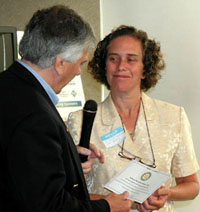|
UW Burn Center: Where Are We Going?
Dr. Nichole Gibran, MD, recently appointed Director of the UW Burn Center, to replace retiring founding director Dr. David Heimbach, appeared at the BBRC Friday with an encouraging message about what is happening in the treatment of burns.
“Burns happen,” opined Dr. Gibran. She posed the question, “Are we ready to handle the threat of burns? In the past 25 years, the UW Burn Center has brought dramatic progress in taking care of burn victims and reducing deaths. The death rate has dropped by half in this period of time. Our Center serves seven7 million people in the Pacific Northwest, an area that covers one-quarter or our country.”
Some of the statistics Dr. Gibran shared revealed the Center has expanded to 46 beds. The average age of patients is 31 years old. The Center has doubled the number of children served. Burns strike more males than females. In fact, 75% of burn injuries are male. The injuries are generally work-related but also include profiles of elderly persons.
Flame or flash injuries are the major incidents treated. Dr. Gibran said there’s been a dramatic drop in electrical injuries.
Over these years, research and new treatment methods have reduced the length of stay in the hospital. “Social progress has made a difference,” said the doctor. “Children’s sleepwear mandated by law with flame retardant has cut down tremendously injuries to small children. Smoke alarms are probably the single-most significant factor in reducing injuries. Home hot water heaters set at a mandated-120 degrees has also reduced burns And, most every school child knows ‘Stop, Drop and Roll,’ in response to training programs when confronted with flames on their bodies.”
Much of the success of reducing the incidence of burns has been the Burn Outreach Program – getting the word to the public about preventing burns.
The Burn Center boasts over 170 people on its staff. One of the major programs is the training of doctors who specialize in the treatment of burns. Twenty-three doctors – trained at the UW Burn Center are working throughout the country today and several as burn center directors across the country. However, there’s an overall national shortage for doctors in this area.
The University of Washington’s program is “pre-eminent – the UW has changed how America takes care of burn victims,” said Dr. Gibran. “Early excision and grafting, early nutritional support, wound care advances (faster healing, less infection), pain management, self-hypnosis, and virtual reality outcomes all have contributed to remarkable changes in burn treatment.”
In one important area, early excision and grafting has produced significant contributions to the field. As recently as the 1970’s, burn patients were housed in the back of the ward, wrapped in bandages, giving off a stench and moaning in pain. That’s how it was, but now is it known that early excision is the key – a total change in approach. We now cut away the dead skin surrounding the burn and begin early grafting. Instead of waiting for the body to heal itself, patients are treated soon after admission.
|

President Evison thanks Dr. Gibran for her presentation.
|
Due to this change of protocol, patients have required fewer reconstructions. Grafts from the person or donors have helped in restoration. “Our results in treating and returning patients to a normal life are much better. However, we have not solved the problem of pain.”
Perhaps one of the most important research findings has been the use of artificial skin – a process called Dermal regeneration. A thin fabric called Integra allows for very thin skin drafts, which makes for quicker healing. Since 1997, the UW Burn Center has had grants worth $5 million, which are responsible for developing better preventive measures, clinical measures, and improved research. “Our five-year plan calls for further accomplishments in reducing mortality, improving outcomes, and continuing outreach education. Getting burn victims back to normal lives is our mission.”
For Dr. Gibran’s informative report on the UW Burn Center, she received a certificate noting the BBRC was donating a book to a needy child at the Kindering Center in Bellevue.
Thanks to Jim Owens for his introduction.
|